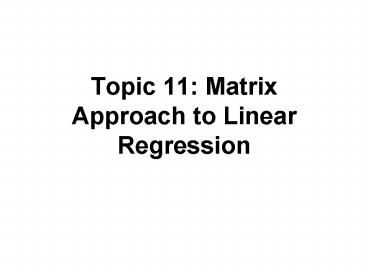Topic 11: Matrix Approach to Linear Regression - PowerPoint PPT Presentation
1 / 23
Title:
Topic 11: Matrix Approach to Linear Regression
Description:
... specify that the covariance between different ?i is zero ... use this framework to do multiple regression where we have more than one explanatory variable ... – PowerPoint PPT presentation
Number of Views:402
Avg rating:3.0/5.0
Title: Topic 11: Matrix Approach to Linear Regression
1
Topic 11 Matrix Approach to Linear Regression
2
Outline
- Linear Regression in Matrix Form
3
The Model in Scalar Form
- Yi ß0 ß1Xi ?i
- The ?i are independent normally distributed
random variables with mean 0 and variance s2 - Consider writing the observations
- Y1 ß0 ß1X1 ?1
- Y2 ß0 ß1X2 ?2
- Yn ß0 ß1Xn ?n
4
The Model in Matrix Form
5
The Model in Matrix Form II
6
The Design Matrix
7
Vector of Parameters
8
Vector of error terms
9
Vector of responses
10
Simple Linear Regression in Matrix Form
11
Variance-Covariance Matrix
Main diagonal values are the variances and
off-diagonal values are the covariances.
12
Covariance Matrix of ?
Independent errors means that the covariance of
any two residuals is zero. Common variance
implies the main diagonal values are equal.
13
Covariance Matrix of Y
14
Distributional Assumptions in Matrix Form
- ? N(0, s2I)
- I is an n x n identity matrix
- Ones in the diagonal elements specify that the
variance of each ?i is 1 times s2 - Zeros in the off-diagonal elements specify that
the covariance between different ?i is zero - This implies that the correlations are zero
15
Least Squares
- We want to minimize (Y-Xß)?(Y-Xß)
- We take the derivative with respect to the
(vector) ß - This is like a quadratic function
- Recall the function we minimized using the
scalar form
16
Least Squares
- The derivative is 2 times the derivative of
(Y-Xß)? with respect to ß - In other words, 2X?(Y-Xß)
- We set this equal to 0 (a vector of zeros)
- So, 2X?(Y-Xß) 0
- Or, X?Y X?Xß (the normal equations)
17
Normal Equations
- X?Y (X?X)ß
- Solving for ß gives the least squares solution b
(b0, b1)? - b (X?X)1(X?Y)
- See NKNW p 200 for details
- The same approach works for multiple
regression!!!!!!
18
Fitted Values
19
Hat Matrix
Well use this matrix when assessing diagnostics
in multiple regression
20
Estimated Covariance Matrix of b
- This matrix, b, is a linear combination of the
elements of Y - These estimates are normal if Y is normal
- These estimates will be approximately normal in
general
21
A Useful MultivariateTheorem
- U N(µ, S), a multivariate normal vector
- V c DU, a linear transformation of U
- c is a vector and D is a matrix
- Then V N(cDµ, DSD?)
22
Application to b
- b (X?X)1(X?Y) ((X?X)1X?)Y
- Since Y N(Xß, s2I) this means the vector b is
normally distributed with mean (X?X)1X?Xß ß
and covariance - s2 ((X?X)1X?) I((X?X)1X?)? s2 (X?X)1
23
Background Reading
- We will use this framework to do multiple
regression where we have more than one
explanatory variable - Another explanatory variable is comparable to
adding another column in the design matrix - See Chapter 6































